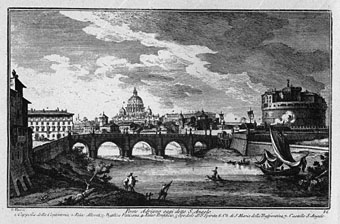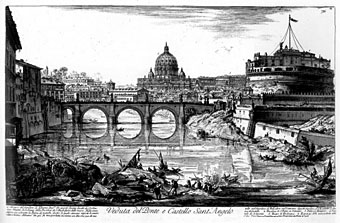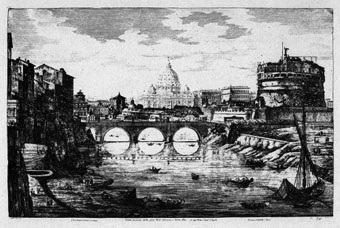Three views of the Ponte Sant’Angelo with St Peter’s basilica in the background and the Castel Sant’Angelo (Hadrian’s Mausoleum) to the right. All from this site, a very thorough guide to Rome’s historic buildings with different views through the ages to the present day. Dover Publications had a book available for a while (now out of print) showing Piranesi’s views of Rome beside photographs of the modern city. In a similar vein, there’s the fascinating Now and Then pool on Flickr, the same idea applied to different places (and people!) around the world.
Giuseppe Vasi.
Piranesi.
Luigi Rossini.
Elsewhere on { feuilleton }
• The etching and engraving archive
Previously on { feuilleton }
• The Cult of Antinous




The Tevere has evoluted very little. A little more construction on the right hand side and the angel has been changed but for the rest…
The Vedute di Roma site is very interesting as it shows the evolution.
As I walk the streets marvelling about all those incredible bits of history jumping right at the visitor – sometimes from the most unexpected site – I often wonder how it was in the past centuries.
In particular wat happened in the area that is now covered by the Monument to Vittorio Emmanuelle. I have found some pictures of the monument’s construction but I still fail to obtain a clear idea of what was the zone like just before. I can just imagine it might have been similar to what I can see now in the nearby ghetto.
The flickr site is also interesting because there are loads of photographies from Holland and that’s where I used to live before moving to Rome.
I used to buy a magazine about the city of Leiden that was dedicated to the evalution of the city – very interesting.
Rome was very different in Piranesi’s time, many of the ancient monuments, especially in the Forum, were buried under several metres of earth, as you can see in this picture:
http://www2.siba.fi/~kkoskim/rooma/kuvat/pira049c.jpg
Those that were visible were very poorly treated, Piranesi shows arches, aquaducts and old walls being used as support for more recent structures like stables and cowsheds! He doesn’t show the area around the Emmanuelle monument unfortunately, the closest you get is the Capitol hill.
And old bricks and stones being stolen to make new houses too…
Whereas there are still plenty of houses or public places that have bits of antic Roman buildings in them, the oddest thing of all must be the houses that are leaning on to Testaccio hill. Since it is an artificial hill deliberately constructed with the remains of the wine and oil amphorae, some of the bars there have their back walls which are literally a slice of history – rubbish history in that case.
When I was there I discovered the Theatrum Marcelli by accident:
http://www2.siba.fi/~kkoskim/imbas/roma/themepage.php?lang=en&action=2&themeid=marcellu
At least they left some things standing; in London they usually just knocked things down and started again. I was also fascinated by the single arch of the ruined bridge in the middle of the Tiber.
By accident ?
Strange, as it is very much present. But I’ll confess a love for that specific area (including the ghetto and the lovely fontana delle tartarughe).
My favourite view of it, from the terrasse of the cafe on top of Musei Capitolini:
http://i67.photobucket.com/albums/h313/spacedlaw/Italy/Roma/P1010053.jpg
It was an accident because I didn’t have a map of all the monuments and so ended up walking past it without knowing it was there. All this talk of Rome reminds me that I should go back there some time!
Great post thanks John. I shall have to wade through the links.
You all make me very jealous. I had a couple of hours in a bar at Rome airport once. It was not a particularly artistic experience however.
I knew of Vasi’s work through:
http://members.tripod.com/romeartlover/index.html
– which, despite its obvious clunky and old school layout, commendably attempts to contrast the old etchings with contemporary photos. [Vasi taught Piranesi I believe]
Yes Piranesi studied under Vasi. Their views above are pretty similar but in other cases Piranesi’s renderings are often more dramatic than those of his former master. And those of artists who came after him, it should be said.